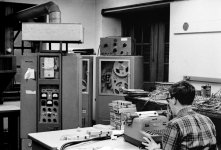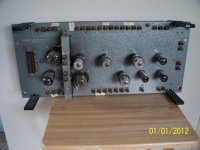Subminiature (T3 outline) tubes have been around since the 1940s. When I was much younger, I used to buy surplus computer boards with 6 RCA 6021 subminiatures (or equivalent), IIRC mostly connected as flip-flops. They were positioned on either side of the PCB, flanked by an aluminum plate with clips on either side--three to a side. Lots of mica caps and such on the board--and really, really cheap--maybe less than a dollar apiece. There was a good reason for this--when a board went bad, it wasn't repaired, just junked and replaced with a new one. So you got 6 tubes, 5 of which might be bad.
This was in the heyday of "Surplus Row" on South Michigan Avenue in Chicago--dark, dusty stores just chock-full of military surplus stuff. It was heaven.
Subminiature "hearing aid" tubes (e.g. HY245) are pre-WWII, as were the 7-pin miniature tubes (e.g. 9001, 9002).
So, no excuse for the "bigness" per se.
One of my old bosses worked on SAGE. He said that one of the first troubleshooting techniques was to first walk down the racks, looking for any tube filaments not glowing. He mentioned that said racks were a convenient unofficial way to keep your lunch warm...
There are still subminiature tubes being sold on eBay.
They appear to be new. Obviously, a great deal of them were manufactured.
Not as small as nuvistors, of course, but pretty small for the time. I suspect that they weren't employed in the like of the G15 and LGP30 because they were often wired right to the circuit (no socket), so not easy to field-service.


